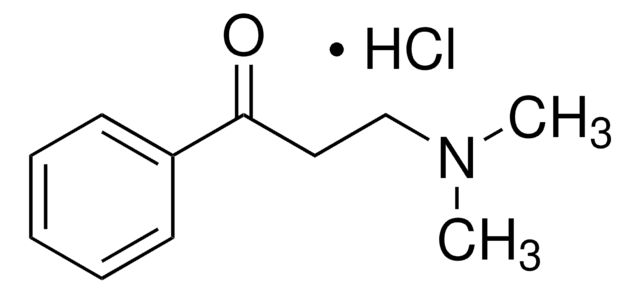1.05588
Sodium hydroxide solution
min. 10% (1.11), for analysis EMSURE®
Synonym(s):
Sodium hydroxide solution
About This Item
Recommended Products
product name
Sodium hydroxide solution min. 10% (1.11), for analysis EMSURE®
vapor pressure
3 mmHg ( 37 °C)
Quality Level
product line
EMSURE®
form
liquid
concentration
10.0-10.5% NaOH
impurities
≤0.0001% Total nitrogen (N)
≤0.0005% Al (Aluminium)
≤0.0005% Chloride (Cl)
≤0.0005% Fe (Iron)
≤0.0005% Heavy metals (as Pb)
≤0.0005% Phosphate (PO4)
≤0.0005% Sulphate (SO?)
≤0.001% Silicate (SiO2)
≤1% Carbonate (as Na2CO3)
pH
13.8 (20 °C in H2O)
density
1.11 g/cm3 at 20 °C
storage temp.
15-25°C
SMILES string
[OH-].[Na+]
InChI
1S/Na.H2O/h;1H2/q+1;/p-1
InChI key
HEMHJVSKTPXQMS-UHFFFAOYSA-M
Looking for similar products? Visit Product Comparison Guide
Application
- Efficient Removal of Aqueous Heavy Metals: A study leveraging sodium hydroxide solution (minimum 10%) in the preparation of Na/N co-doped seaweed biochar composites for the removal of Pb(II) and Cu(II) from water. This research underscores the role of sodium hydroxide in environmental remediation technologies (Fu et al., 2024).
- Acute Esophagitis Model: Sodium hydroxide solution is utilized in the treatment of acute esophagitis in a rat model, highlighting its potential therapeutic applications in biomedical research (Gurlek et al., 2024).
- Dye Adsorption: The solution is used in the synthesis of kaolin-supported nickel oxide composites for catalytic oxidative degradation of methylene blue dye, serving as a pivotal study in water treatment and chemical engineering (Mohammed et al., 2024).
- Chitosan Production: Research on the production of chitosan from shrimp shell utilizing sodium hydroxide solution followed by subcritical water hydrolysis, illustrating its critical role in advancing material science and sustainable production methods (Matouri et al., 2024).
Analysis Note
Carbonate (as Na₂CO₃): ≤ 1 %
Chloride (Cl): ≤ 0.0005 %
Phosphate (PO₄): ≤ 0.0005 %
Silicate (SiO₂): ≤ 0.001 %
Sulphate (SO₄): ≤ 0.0005 %
Total nitrogen (N): ≤ 0.0001 %
Heavy metals (as Pb): ≤ 0.0005 %
Al (Aluminium): ≤ 0.0005 %
Fe (Iron): ≤ 0.0005 %
Legal Information
Signal Word
Danger
Hazard Statements
Precautionary Statements
Hazard Classifications
Eye Dam. 1 - Met. Corr. 1 - Skin Corr. 1A
Storage Class Code
8B - Non-combustible, corrosive hazardous materials
WGK
WGK 1
Flash Point(F)
Not applicable
Flash Point(C)
Not applicable
Certificates of Analysis (COA)
Search for Certificates of Analysis (COA) by entering the products Lot/Batch Number. Lot and Batch Numbers can be found on a product’s label following the words ‘Lot’ or ‘Batch’.
Already Own This Product?
Find documentation for the products that you have recently purchased in the Document Library.
Customers Also Viewed
Protocols
Photometric determination with pyridylazoresorcinol (PAR) subsequent to acid extraction
Related Content
Our ergonomic 1 L HDPE bottle for acids, bases, and solvents provide an alternative to glass chemical bottles for lab safety in pouring & handling of hazardous chemicals in the laboratory.
Our ergonomic 1 L HDPE bottle for acids, bases, and solvents provide an alternative to glass chemical bottles for lab safety in pouring & handling of hazardous chemicals in the laboratory.
Our ergonomic 1 L HDPE bottle for acids, bases, and solvents provide an alternative to glass chemical bottles for lab safety in pouring & handling of hazardous chemicals in the laboratory.
Our ergonomic 1 L HDPE bottle for acids, bases, and solvents provide an alternative to glass chemical bottles for lab safety in pouring & handling of hazardous chemicals in the laboratory.
Our team of scientists has experience in all areas of research including Life Science, Material Science, Chemical Synthesis, Chromatography, Analytical and many others.
Contact Technical Service






